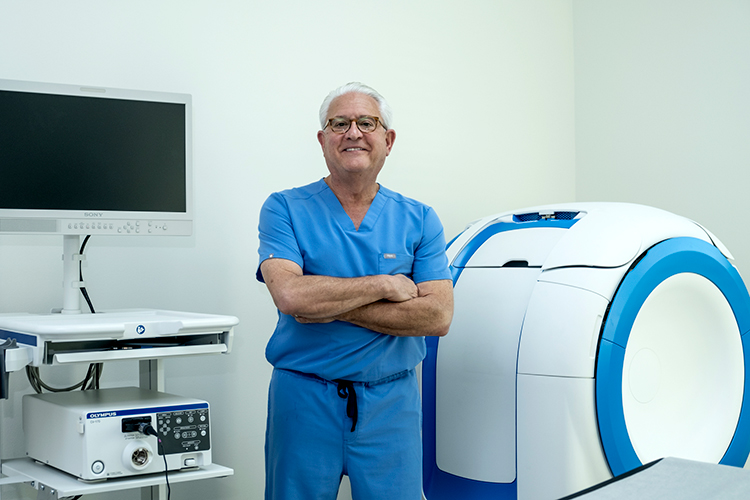Most men over 50 will begin having signs of benign prostatic hyperplasia (BPH), more commonly referred to as an enlarged prostate, according to Dr. Marc Rose, who has been a urologist in Vero Beach for nearly 30 years.
“By 60 years of age, the prevalence of BPH is over 50 percent and the condition affects about 90 percent of those over 85 years of age,” according to the National Institutes of Health Library of Medicine.
With BPH, men may notice they have to urinate more frequently with more urgency, yet their stream of urine is slower. Some may have occasional bouts of incontinence and recurring infections. While these symptoms are unpleasant, they are in most cases curable with improved imaging and treatment technologies.
“For a long time, the only treatment for BPH was a transurethral resection of the prostate, a surgical procedure that involved cutting away a section of the prostate,” Dr. Rose said.
“We called it the ‘roto-rooter’ because we went in and scraped out the excess tissue in the prostate. Fortunately, newer technology has given us better, more precise, non-surgical treatments.”
One of the alternatives is the UroLift procedure, which utilizes tiny implants to lift and hold the enlarged prostate tissue out of the way so it no longer blocks the urethra. There is no cutting, heating or removal of prostate tissue. And sexual function is preserved.
“The procedure was approved by the FDA in 2013 and the American Urological Association began recommending it as a standard of care option in 2018,” according to Harvard Health Publishing. It is now becoming popular with a growing number of urologists.
“During the UroLift procedure we insert clips with a suture between them that holds the prostate apart,” said Dr. Rose. “With BPH the sides of the prostate come together and squeeze the channel making it hard to pass the urine through that narrow channel. The clips and sutures between them pulls the prostate apart so the urine stream can be better.
I was one of the first urologists in Florida to do the UroLift procedure.”
Dr. Rose also discussed aquablation, a technique that was approved by the FDA five years ago but still is not widespread.
“Aquablation is the latest and greatest technology and I am one of only a few doctors in the area who are currently doing this procedure,” Dr. Rose said. “Currently the only aquablation machine near here is at HCA St. Lucie Hospital, so I travel down there to do the procedure. This is a wonderful option for someone with an enlarged, benign prostate who has trouble urinating. It’s basically a water jet with heat that removes excess prostate tissue and opens the channel.”
“The procedure is done in the hospital since it’s the only place with the machine,” Dr. Rose explained. “The patient is sedated, and an ultrasound probe is inserted in the anus to transmit the visual of the prostate on the screen. A special scope is inserted into the channel way or urethra and is positioned properly. The two [images] are coordinated by a robot and there is great visualization on the screen. This gives the doctor the ability to mark where the limits of treatment will be, staying away from the external muscle that controls urination, which helps prevent incontinence after the procedure.
“Once everything is set up and aligned properly, the doctor presses a button or foot pedal to activate the nozzle in the special scope. The nozzle gives off a jet stream of water much like a water pressure washer for your house as it moves back and forth from the bladder to the end of the prostrate to eliminate the excess tissue.
“At the end of the procedure a scope flushes out any tissue. A catheter is put in and stays in for about three days to keep it draining. Once the catheter is removed, the tissue that was destroyed with the water jet and is still in the prostate gradually expels through the urine.”
Dr. Rose uses the new Promax MRI device, which was approved in 2021. It is a low-power MRI that merges two MRI pictures together for a more accurate image of the prostate, refining the standard of care by improving the quality and speed of patient diagnosis and interventions.
“The Promax MRI allows us to compare two MRIs more accurately to determine the areas that should be biopsied,” Dr. Rose said.
Dr. Rose has been a urologist in Vero Beach for nearly three decades, including 20 years as a partner in a private practice, and then as part of the Cleveland Clinic Indian River Hospital doctors group, starting in 2016. He recently returned to private practice and opened his own office, Rose Urology, with the latest technology and equipment and a focus on preventative medicine for men.
Dr. Rose offers a traditional model of care for those who prefer to have their insurance billed in a fee for service manner and a membership model of care for those seeking a more concierge-like service.
Members have unlimited, direct access to the doctor with a private number, same-day appointments and coordination of their overall care for about $3,000 per year. The traditional fee-for-service patients are managed by Rose Urology’s skilled nurse practitioner, Valerie Ward. Dr. Rose performs all surgeries and procedures.
Dr. Rose received his Doctor of Medicine degree from the Ohio State University College of Medicine and completed his surgery internship and his Urology residency at the Cleveland Clinic Foundation in Cleveland Ohio. He welcomes new patients at his new office, Rose Urology, located at 49 Royal Palm Pointe in Vero Beach. Call 772- 564-1799 to schedule an appointment or to learn more about his membership program.

